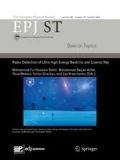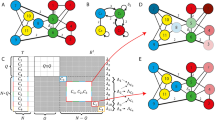Abstract
We investigate cluster formation in populations of coupled chaotic model neurons under homogeneous global coupling, and distance-dependent coupling, where the coupling weights between neurons depend on their relative distance. Three types of clusters emerge for global coupling: synchronized cluster, two state cluster and anti-phase cluster. In addition to these, we find a novel three state cluster for distance-dependent coupling, where the population splits into two synchronized groups and one incoherent group. Lastly, we study a system with random inhomogeneous coupling strengths, in order to discern if the special pattern found in distance-dependent coupling arises from the underlying lattice structure or from the inhomogeneity in coupling.
Similar content being viewed by others
References
A. Pikovsky, M. Rosenblum, J. Kurths, Synchronization: A Universal Concept in Nonlinear Sciences (Cambridge University Press, 2001)
J. Crutchfield, K. Kaneko, Directions in Chaos, edited by B.L. Hao (World Scientific, Singapore, 1987)
P. Alstrom, R.K. Ritala, Phys. Rev. A 35, 300 (1987)
P. Hadley, K. Weisenfeld, Phys. Rev. Lett. 62, 1335 (1989)
K. Wiesenfeld, P. Colet, S. Strogatz, Phys. Rev. Lett. 76, 404 (1996)
K. Kaneko, Phys. Rev. Lett. 63, 219 (1989)
G. Perez, S. Sinha, H.A. Cerdeira, Physica D 63, 341 (1993)
K. Kaneko, Physica D 23, 436 (1986)
K. Kaneko, Physica D 37, 60 (1989)
K. Kaneko, Physica D 41, 137 (1990)
K. Kaneko, Physica D 54, 5 (1991)
S. Manruiba, A. Mikhailov Phys. Rev. E 60, 1579 (1999)
D.H. Zanette, A.S. Mikhailov, Phys. Rev. E 57, 276 (1998)
A.S. Kuznetsov, J. Kurths, Phys. Rev. E 66, 026201 (2002)
A. Koseska, E. Volkov, A. Zaikin, J. Kurths, Phys. Rev. E 75, 031916 (2007)
A. Koseska, E. Ullner, E. Volkov, J. Kurths, J. Garca-Ojalvo, J. Theor. Biol. 263, 189 (2010)
K. Miyakawa, K. Yamada, Physica D 151, 217 (2001)
W. Wang, I.Z. Kiss, J.L. Hudson, Chaos: An Interdisciplinary J. Nonlinear Sci. 10, 248 (2000)
W. Wang, I.Z. Kiss, J.L. Hudson, Phys. Rev. Lett. 86, 4954 (2001)
I.Z. Kiss, J.L. Hudson, Chaos: An Interdisciplinary J. Nonlinear Sci. 13, 999 (2003)
Y. Jiang, Phys. Lett. A 267, 342 (2000)
J.L. Rogers, L.T. Wille, Phys. Rev. E 54, R2193 (1996)
S.E. de S. Pinto, R.L. Viana, Phys. Rev. E 61, 5154 (2000)
C.F. Woellner, S.R. Lopes, R.L. Viana, I.L. Caldas, Chaos, Solitons Fractals 41, 2201 (2009)
G. Tang, K. Xu, L. Jiang, Phys. Rev. E 84, 046207 (2011)
C. Masoller, A.C. Marti, D. Zanette, Physica A 325, 186 (2003)
A.C. Marti, C. Masoller, Phys. Rev. E 67, 056219 (2003)
A.C. Marti, C. Masoller, Physica A 342, (2004) 344
D.R. Chialvo, Chaos, Solitons Fractals 5, 461 (1995)
P.J. Davis, Circulant Matrices (Wiley, New York, 1979)
P. Gade, R. Amritkar, Phys. Rev. E 47, 143 (1993)
Author information
Authors and Affiliations
Corresponding authors
Rights and permissions
About this article
Cite this article
Kamal, N.K., Sinha, S. Cluster formation in populations of coupled chaotic neurons. Eur. Phys. J. Spec. Top. 222, 905–915 (2013). https://doi.org/10.1140/epjst/e2013-01893-0
Received:
Revised:
Published:
Issue Date:
DOI: https://doi.org/10.1140/epjst/e2013-01893-0




